

Response. How does the UN define response?
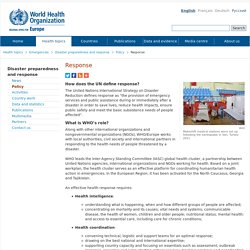
The United Nations International Strategy on Disaster Reduction defines response as “the provision of emergency services and public assistance during or immediately after a disaster in order to save lives, reduce health impacts, ensure public safety and meet the basic subsistence needs of people affected”. What is WHO’s role? Along with other international organizations and nongovernmental organizations (NGOs), WHO/Europe works with local authorities, civil society and international partners in responding to the health needs of people threatened by a disaster. WHO leads the Inter-Agency Standing Committee (IASC) global health cluster, a partnership between United Nations agencies, international organizations and NGOs working for health.
Based on a joint workplan, the health cluster serves as an effective platform for coordinating humanitarian health action in emergencies. An effective health response requires: State of the Climate 2018. Redirecting. JavaScript is disabled on your browser.
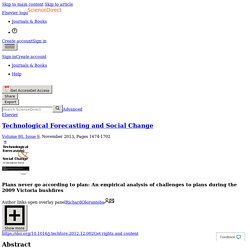
Please enable JavaScript to use all the features on this page. Abstract Uncertainty is a major challenge for emergency, disaster and public safety decision-makers when planning and preparing for disasters and when executing plans. This research explores unexpected challenges to the Victoria State disaster plan before and during the “Black Saturday” Australian bushfires of 7 February, 2009 that significantly contributed to the scale of the disaster in which 173 persons perished. The article adopts Barry Turner's sequence model of intelligence failure to frame the empirical analysis. Beyond Bushfires: Community, Resilience and Recovery - a longitudinal mixed method study of the medium to long term impacts of bushfires on mental health and social connectedness. Changing patterns in global climate have resulted in growing awareness that natural disasters will probably increase in the coming years, resulting in more bushfires, severe storms, and flooding that can pose a threat to individual and social well-being [1].
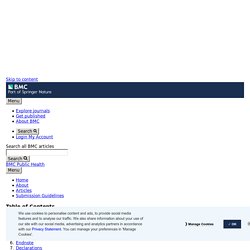
What a century of bushfire data teaches us about how to save lives this summer. What has Australia learned from Black Saturday? Black Saturday was a day like no other; it will be forever remembered in the history of bushfire disasters in Australia.
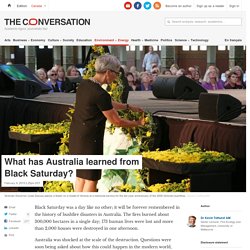
The fires burned about 300,000 hectares in a single day; 173 human lives were lost and more than 2,000 houses were destroyed in one afternoon. Smoke from Gell River bushfire causes 'extreme' air pollution. Updated 4 Jan 2019, 11:14pmFri 4 Jan 2019, 11:14pm "Extreme" air pollution levels have been recorded in parts of the Derwent Valley as a result of bushfires burning near Gell River in Tasmania's South West Wilderness, prompting a warning from experts about the health risks.
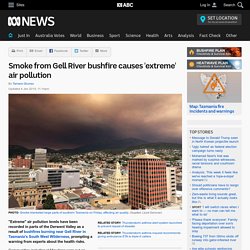
Key points: Smoke from the massive Gell River fire blanketed parts of southern TasmaniaAir pollution expert warns smoke particles could cause significant symptoms in some peopleThose most at risk are the elderly and people with chronic medical conditions Communities including at Maydena were put on alert on Friday but a late cool change shifted winds west-north-westerly, and temperatures dropped more than 15 degrees Celsius to the mid 20s. The fire was downgraded to advice level overnight and conditions on the Gell River fire ground are expected to improve today. Background levels are usually 5 ppm or less. Environmental/Social/Economic Impacts - ABC BUSHFIRES. Beyond bushfires 2019 update Feb.
DEA Bushfires Fact Sheet. RSPCA Victoria – The Impacts of the Black Saturday Bushfires – Australian Rotary Health. Nearly six years after the Black Saturday bushfires, a new study shows a quarter of survivors from the worst affected Victorian communities are still experiencing serious mental health problems.
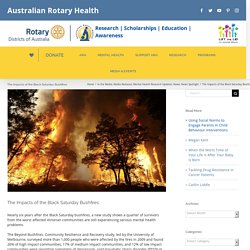
The Beyond Bushfires: Community Resilience and Recovery study, led by the University of Melbourne, surveyed more than 1,000 people who were affected by the fires in 2009 and found 26% of high impact communities, 17% of medium impact communities, and 12% of low impact communities were reporting symptoms of depression, post-traumatic stress disorder (PTSD) or severe psychological distress. The aim of the study was to examine the impacts the bushfires had on community members physical and mental health and well-being. The research also aimed to build understanding of the interplay between individual, social and community-level recovery.
Australian Rotary Health CEO, Joy Gillett said Rotary clubs and districts around Australia were keen to help by providing funds for the Beyond Bushfires study. Doctors for the Environment Australia. A good possum is hard to find - Museums Victoria. Bushfires and burnoffs - An Asthma Australia site. Prepare your home - NSW Rural Fire Service. A well prepared home is more likely to survive a bush fire.
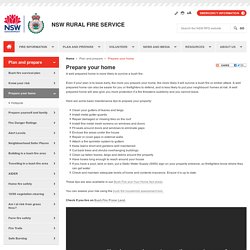
Even if your plan is to leave early, the more you prepare your home, the more likely it will survive a bush fire or ember attack. VicEmergency App - Country Fire Authority. Bushfire preparation. Large spring bushfires and predictions of a hot, dry summer are sending a strong reminder to households in fire zones to prepare for a higher risk this bushfire season.
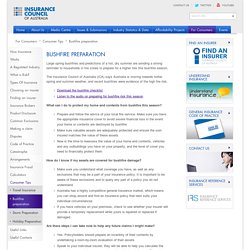
The Insurance Council of Australia (ICA) says Australia is moving towards hotter spring and summer weather, and recent bushfires were evidence of the high fire risk. Stop Bushfire Arson. Bushfire arson is a crime, and a major threat to all Australians.
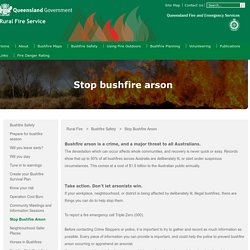
The devastation which can occur affects whole communities, and recovery is never quick or easy. Records show that up to 50% of all bushfires across Australia are deliberately lit, or start under suspicious circumstances. Emergency Management Victoria. 15 November, 2016 The new VicEmergency app provides Victorians with access to warnings and incidents for fires, floods, storms, earthquake, tsunamis and water safety.
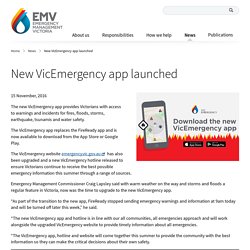
The VicEmergency app replaces the FireReady app and is now available to download from the App Store or Google Play. The VicEmergency website emergency.vic.gov.au (External link) has also been upgraded and a new VicEmergency hotline released to ensure Victorians continue to receive the best possible emergency information this summer through a range of sources. Your Bushfire Plan: The Basics - Country Fire Authority. Prepare for bushfire season. An unprepared property is not only at risk itself, but may also present an increased danger for neighbours.
Here are some things you can do: Structure Clear leaves, twigs, bark and other debris from the roof and gutters.Purchase and test the effectiveness of gutter plugs.Enclose open areas under decks and floors.Install fine steel wire mesh screens on all windows, doors, vents and weep holes.Point LPG cylinder relief valves away from the house.Conduct maintenance checks on pumps, generators and water systems.Seal all gaps in external roof and wall cladding. Access Display a prominent house or lot number, in case it is required in an emergency.Ensure there is adequate access to your property for fire trucks - 4 metres wide by 4 metres high, with a turn-around area. Vegetation Personal. Bushfire arson. Bushfire arson Bushfire arson has a devastating impact on the community. It has the potential to injure or kill people, cause significant financial loss, and destroy property as well as the environment. Bushfire Arson Prevention Policy Statement 2015-18.
Australiawidefirstaid.com.
Carly's Additional Resources. Su Qi's Additional Resources. Tilly's Additional Resources.